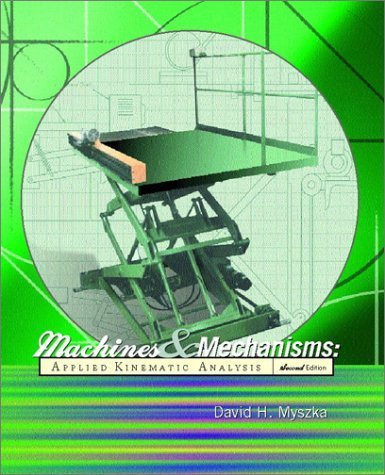Machines and Mechanisms: Applied Kinematic Analysis (2nd Edition) - Hardcover

"synopsis" may belong to another edition of this title.
Machines and Mechanisms: Applied Kinematic Analysis, Second Edition, applies kinematic theories, both graphical and analytical, to real-world machines. It is intended to bridge the gap between a theoretical study of kinematics and the application to practical mechanisms.
This text meets the need for an introduction to kinematic analysis that uses actual machines and mechanisms. The objective of this book (consistent with the philosophy of engineering and technology programs) is to provide the techniques necessary to study the motion of machines while emphasizing the application of kinematic theories to real-world machines.
Distinctive features of this book include:
- Case studies at the end of every chapter illustrate a mechanism used on industrial equipment and help students to see the practical application of the material they are studying.
- Focus on the application of every chapter illustrate a mechanism used on equipment and help students the practical application of the material they are studying.
- Introduces students to modern tools of the trade through suggestions for implementing the graphical techniques on computer-aided design (CAD) systems and suggestions for using programmable devices (calculators, spreadsheets, math software, etc.) for analytical solution procedures
The objective of this book is to provide the techniques necessary to study the motion of machines. A focus is placed on the application of kinematic theories to real-world machinery. It is intended to bridge the gap between a theoretical study of kinematics and the application to practical mechanisms. Students completing a course of study using this book should be able to determine the motion characteristics of a machine. Further, such analysis could be performed on design concepts to optimize the motion of a machine arrangement.
This second edition incorporates much of the feedback received from instructors and students who used the first edition of the book. First, a thorough examination of the accuracy for all equations and Example Problem solutions was performed. Second, solution steps have been added to the Example Problems, highlighting the general solution procedure. Third, the material on mechanism force analysis has been greatly expanded. These and many other modifications were made to more effectively promote the understanding of mechanism analysis.
It is expected that students using this book will have a good background in technical drawing, college algebra, and trigonometry. Also, knowledge of vectors, mechanics, and computer application software, such as spreadsheets, will be useful. However, these concepts are also introduced in the book.
The approach of applying theoretical developments to practical problems is consistent with the philosophy of engineering technology programs. This book is primarily oriented toward mechanical- and manufacturing-related engineering technology programs. It can be used in either associate or baccalaureate degree programs.
Following are some distinctive features of this book:
- Pictures and sketches of machinery that contain mechanisms are incorporated throughout the text.
- The focus is on the application of kinematic theories to practical mechanisms.
- Both graphical techniques and analytical methods are used in the analysis of mechanisms.
- A student copy of Working Model™ a commercially available dynamic software package, is extensively used in this book. Tutorials and problems that utilize this software are integrated into the book.
- Suggestions for implementing the graphical techniques on computer-aided design (CAD) systems are included.
- Every chapter concludes with a few case studies. These cases illustrate a mechanism that is used on industrial equipment and challenges the student to discuss the rationale behind the design and suggest improvements.
- Both static and dynamic mechanism force analysis methods are introduced.
- Every major concept is followed by an example problem to illustrate the application of the concept.
- Every example problem begins with an introduction of a real machine that relies on the mechanism being analyzed.
- Numerous end-of-chapter problems are consistent with the application approach of the text. Every concept introduced in the chapter has at least one associated practice problem. Most of these problems include the machine that relies on the mechanism being analyzed.
- Where applicable, end-of-chapter problems are provided that utilize the analytical methods and are best suited for programmable devices (calculators, spreadsheets, math software, etc.)
- Initially, I developed this textbook after teaching mechanisms for several semesters and noticing that students did not always see the practical applications of the material. To this end, I have grown quite fond of the case study problems and begin each class with one. The students refer to this as the "mechanism of the day." I find this to be an excellent opportunity to focus attention on operating machinery. Additionally, it promotes dialog and creates a learning community in the classroom.
Finally, the purpose of any textbook is to guide the students through a learning experience in an effective manner. I sincerely hope that this book will fulfill this intention. I welcome all suggestions and comments and can be reached at dmyszka@udayton.edu.
ACKNOWLEDGEMENTS
I thank the reviewers of this text for their comments and suggestions: Guenter W. Brunner, Owens Community College; Laura Caldwell, University of Cincinnati; and Robert Tosch, Alpena Community College.
Dave Myszka
"About this title" may belong to another edition of this title.
- PublisherPrentice Hall
- Publication date2001
- ISBN 10 0130306800
- ISBN 13 9780130306807
- BindingHardcover
- Number of pages516
- Rating
Buy New
Learn more about this copy
Shipping:
FREE
Within U.S.A.
Top Search Results from the AbeBooks Marketplace
Machines and Mechanisms: Applied Kinematic Analysis (2nd Edition)
Book Description Hardcover. Condition: New. Seller Inventory # Abebooks2233

